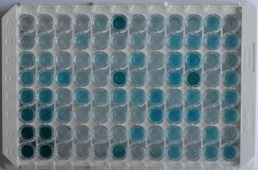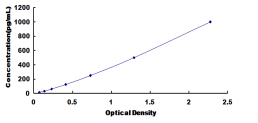Packages (Simulation)

Reagent Preparation

Image (I)
Image (II)
Certificate


ELISA Kit for Troponin T Type 2, Cardiac (TNNT2)
CMH2; cTnT; TnTc; Cardiomyopathy,Hypertrophic 2; Cardiac muscle troponin T
- Product No.SED232Rb
- Organism SpeciesOryctolagus cuniculus (Rabbit) Same name, Different species.
- Sample TypeSerum, plasma and other biological fluids.
- Test MethodDouble-antibody Sandwich
- Assay Length3h
- Detection Range15.62-1000pg/mL
- SensitivityThe minimum detectable dose of this kit is typically less than 6.2pg/mL.
- DownloadInstruction Manual
- UOM 48T96T 96T*5 96T*10 96T*100
- FOB
US$ 532
US$ 760
US$ 3420
US$ 6460
US$ 53200
For more details, please contact local distributors!
Specificity
This assay has high sensitivity and excellent specificity for detection of Troponin T Type 2, Cardiac (TNNT2).
No significant cross-reactivity or interference between Troponin T Type 2, Cardiac (TNNT2) and analogues was observed.
Recovery
Matrices listed below were spiked with certain level of recombinant Troponin T Type 2, Cardiac (TNNT2) and the recovery rates were calculated by comparing the measured value to the expected amount of Troponin T Type 2, Cardiac (TNNT2) in samples.
| Matrix | Recovery range (%) | Average(%) |
| serum(n=5) | 80-97 | 89 |
| EDTA plasma(n=5) | 82-103 | 101 |
| heparin plasma(n=5) | 95-102 | 99 |
Precision
Intra-assay Precision (Precision within an assay): 3 samples with low, middle and high level Troponin T Type 2, Cardiac (TNNT2) were tested 20 times on one plate, respectively.
Inter-assay Precision (Precision between assays): 3 samples with low, middle and high level Troponin T Type 2, Cardiac (TNNT2) were tested on 3 different plates, 8 replicates in each plate.
CV(%) = SD/meanX100
Intra-Assay: CV<10%
Inter-Assay: CV<12%
Linearity
The linearity of the kit was assayed by testing samples spiked with appropriate concentration of Troponin T Type 2, Cardiac (TNNT2) and their serial dilutions. The results were demonstrated by the percentage of calculated concentration to the expected.
| Sample | 1:2 | 1:4 | 1:8 | 1:16 |
| serum(n=5) | 88-95% | 97-105% | 78-97% | 99-105% |
| EDTA plasma(n=5) | 81-88% | 81-92% | 96-104% | 78-104% |
| heparin plasma(n=5) | 78-97% | 93-105% | 78-97% | 84-92% |
Stability
The stability of kit is determined by the loss rate of activity. The loss rate of this kit is less than 5% within the expiration date under appropriate storage condition.
To minimize extra influence on the performance, operation procedures and lab conditions, especially room temperature, air humidity, incubator temperature should be strictly controlled. It is also strongly suggested that the whole assay is performed by the same operator from the beginning to the end.
Reagents and materials provided
| Reagents | Quantity | Reagents | Quantity |
| Pre-coated, ready to use 96-well strip plate | 1 | Plate sealer for 96 wells | 4 |
| Standard | 2 | Standard Diluent | 1×20mL |
| Detection Reagent A | 1×120µL | Assay Diluent A | 1×12mL |
| Detection Reagent B | 1×120µL | Assay Diluent B | 1×12mL |
| TMB Substrate | 1×9mL | Stop Solution | 1×6mL |
| Wash Buffer (30 × concentrate) | 1×20mL | Instruction manual | 1 |
Assay procedure summary
1. Prepare all reagents, samples and standards;
2. Add 100µL standard or sample to each well. Incubate 1 hours at 37°C;
3. Aspirate and add 100µL prepared Detection Reagent A. Incubate 1 hour at 37°C;
4. Aspirate and wash 3 times;
5. Add 100µL prepared Detection Reagent B. Incubate 30 minutes at 37°C;
6. Aspirate and wash 5 times;
7. Add 90µL Substrate Solution. Incubate 10-20 minutes at 37°C;
8. Add 50µL Stop Solution. Read at 450nm immediately.
GIVEAWAYS
INCREMENT SERVICES
-
 Single-component Reagents of Assay Kit
Single-component Reagents of Assay Kit
-
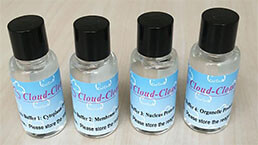 Lysis Buffer Specific for ELISA / CLIA
Lysis Buffer Specific for ELISA / CLIA
-
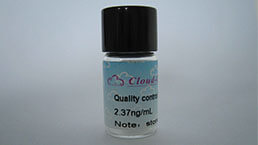 Quality Control of Kit
Quality Control of Kit
-
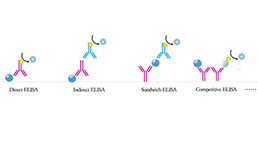 ELISA Kit Customized Service
ELISA Kit Customized Service
-
 Disease Model Customized Service
Disease Model Customized Service
-
 Serums Customized Service
Serums Customized Service
-
 TGFB1 Activation Reagent
TGFB1 Activation Reagent
-
 Real Time PCR Experimental Service
Real Time PCR Experimental Service
-
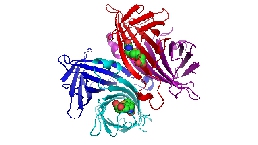 Streptavidin
Streptavidin
-
 Fast blue Protein Stain solution
Fast blue Protein Stain solution
-
 Single-component Reagents of FLIA Kit
Single-component Reagents of FLIA Kit
-
 Streptavidin-Agarose Beads
Streptavidin-Agarose Beads
| Magazine | Citations |
| Basic & Clinical Pharmacology & Toxicology | Cardioprotective Effect of Sulphonated Formononetin on Acute Myocardial Infarction in Rats PubMed: 21232020 |
| Basic & Clinical Pharmacology & Toxicology | Cardioprotective Effect of SMND-309, A Novel Derivate of Salvianolic Acid B on Acute Myocardial Infarction in Rats Wiley: source |
| European Journal of Pharmacology | Protective roles of Asperosaponin VI, a triterpene saponin isolated from Dipsacus asper Wall on acute myocardial infarction in rats ScienceDirect: S0014299909009984 |
| Journal of translational medicine | The altered expression profile of microRNAs in cardiopulmonary bypass canine models and the effects of mir-499 on myocardial ischemic reperfusion injury PubMed: PMC3694448 |
| Oral Diseases | Salivary high‐sensitivity cardiac troponin T levels in patients with acute myocardial infarction Pubmed: 22834943 |
| An International Journal of Pharmaceutical Sciences | In vivo and in vitro cardioprotective effects of Panax quinquefolium 20 (S)-protopanaxadiol saponins (PQDS), isolated from Panax quinquefolium Pubmed: 23700796 |
| Journal of Animal and Feed Sciences, | The effects of caloric restriction and age on thyroid hormone signalling in the heart of rats Pl:Source |
| Liver Int. | Cardiomyopathy reverses with recovery of liver injury, cholestasis and cholanemia in mouse model of biliary fibrosis Pubmed:24330504 |
| Cardiovasc Toxicol. | Cardioprotective Effect of Rhizomes of Acorus gramineus Against Isoproterenol-Induced Cardiac Damage in Pigs Pubmed:24420420 |
| British Journal of Pharmacology | Glutathione administration reduces mitochondrial damage and shifts cell death from necrosis to apoptosis in ageing diabetic mice hearts during exercise Pubmed:25039894 |
| Chemico-Biological Interactions | Crocin protects against doxorubicin-induced myocardial toxicity in rats through down-reCavia (Guinea pig )lation of inflammatory and apoptic pathways Pubmed:26807765 |
| The Journal of Pharmacology and Experimental Therapeuties | The Cardenolide Glycoside Acovenoside A Affords Protective Activity in Doxorubicin-Induced Cardiotoxicity in Mice Pubmed:27247000 |
| The Journal of Maternal-Fetal & Neonatal Medicine | Troponins, heat shock proteins and glycogen phosphorylase BB in umbilical cord blood of complicated pregnancies. pubmed:27937003 |
| PLoS One. | Outer Balloon Ligation Increases Success Rate of Ischemia-Reperfusion Injury Model in Mice. pubmed:27907155 |
| Biomedicine & Pharmacotherapy | Rosuvastatin improves myocardial and neurological outcomes after asphyxial cardiac arrest and cardiopulmonary resuscitation in rats pubmed:28076830 |
| PLoS One | Imatinib attenuates cardiac fibrosis by inhibiting platelet-derived growth factor receptors activation in isoproterenol induced model pubmed:28570599 |
| EXPERIMENTAL AND THERAPEUTIC MEDICINE | Cardioprotective effect of Notch signaling on the development of myocardial infarction complicated by diabetes mellitus pubmed:29042932 |
| PLoS One | Increases in plasma corin levels following experimental myocardial infarction reflect the severity of ischemic injury Pubmed: 30192780 |
| PLoS One | Tissue suction-mediated gene transfer to the beating heart in mice Pubmed: 32027678 |
| Journal of Human Kinetics | Hormonal Response to Incremental and Continuous Exercise in Cyclists with Left Ventricle Hypertrophy Pubmed: 32148580 |
| BIOMEDICINE & PHARMACOTHERAPY | Chlorogenic acid prevents acute myocardial infarction in rats by reducing inflammatory damage and oxidative stress Pubmed: 33022535 |
| Toxics | Norepinephrine Leads to More Cardiopulmonary Toxicities than Epinephrine by Catecholamine Overdose in Rats Pubmed: 32947820 |
| Elife | Iron derived from autophagy-mediated ferritin degradation induces cardiomyocyte death and heart failure in mice 33526170 |
| Cell Metabolism | Pharmacological inhibition of arachidonate 12-lipoxygenase ameliorates myocardial ischemia-reperfusion injury in multiple species 34536344 |
| Anal Bioanal Chem | Development of a novel ssDNA aptamer targeting cardiac troponin I and its clinical applications 34673993 |
| Experimental and Therapeutic Medicine | Hydrogen therapy after resuscitation improves myocardial injury involving inhibition of autophagy in an asphyxial rat model of cardiac arrest Pubmed:35495584 |
| Catalog No. | Related products for research use of Oryctolagus cuniculus (Rabbit) Organism species | Applications (RESEARCH USE ONLY!) |
| RPD232Rb01 | Recombinant Troponin T Type 2, Cardiac (TNNT2) | Positive Control; Immunogen; SDS-PAGE; WB. |
| PAD232Rb51 | Polyclonal Antibody to Troponin T Type 2, Cardiac (TNNT2) | WB; IHC; ICC; IP. |
| MAD232Rb21 | Monoclonal Antibody to Troponin T Type 2, Cardiac (TNNT2) | WB; IHC; ICC; IP. |
| SED232Rb | ELISA Kit for Troponin T Type 2, Cardiac (TNNT2) | Enzyme-linked immunosorbent assay for Antigen Detection. |
| LMD232Rb | Multiplex Assay Kit for Troponin T Type 2, Cardiac (TNNT2) ,etc. by FLIA (Flow Luminescence Immunoassay) | FLIA Kit for Antigen Detection. |

